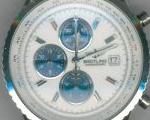A chronograph is an electronic instrument that has one or more hands that can be stopped on command for the explicit purpose of measuring elapsed time.

A chronograph is an electronic instrument that has one or more hands that can be stopped on command for the explicit purpose of measuring elapsed time. You may have never heard of a chronograph, but you certainly know what stopwatches are. They are one in the same. Today they come in two basic forms, mechanical and digital.
Mechanical chronograph, just like with wristwatches, operate on a spring mechanism and must be manually wound. The controls usually consist of two or three pushbuttons. Pressing the buttons starts and stops the time tracking mechanism, displayed by second and minute hands, which can be reset to a starting position by pushing an additional button.
For most purposes, mechanical chronographs are accurate enough, though anyone desiring a high degree of accuracy will use a digital stopwatch. An example of someone that would need the digital version would be a track and field athlete or any number of other athletic endeavors where time is measured by the split second. These precision timepieces have the capability of displaying tenths, hundredths, even thousandths of seconds, and using the same extremely accurate and reliable oscillator found in quartz watches. Digital chronographs are without a doubt the most popular form of the chronograph today. As technology has improved in, so to has the accuracy of the timepiece.
The first chronograph like instrument was developed in 1720 by an Englishman named Graham, who is today referred to as "the Father of the Chronograph". He basically and then it a clock that could be quickly started and stopped and was accurate to within 1/16 of a second. Although by today's standards that is horribly inaccurate, it was a fantastic achievement at that time.
The first actual chronograph was made about a century later by a Frenchman named Rieussec. His clock had dots on it to measure the elapsed time, and was the first to bear the name "chronograph". His invention used a pen to mark onto the dial itself an arc whose length could be used to measure how long the mechanism had operated for. It was a very intricate mechanism that proved to be quite accurate and reliable.
The Greek roots of the word "chronograph" suggest that it actually means "time writing", and since Rieussec's invention was the only one to involve writing it is the only real chronograph. Chronographs today are all called stopwatches because I believe if you were to ask anyone in about a chronograph, they would have no idea what you're talking about. Although it is technically a misnomer, many people still refer to stopwatches as chronographs, and the names are for nearly all intents and purposes interchangeable.
It is commonplace now to see wristwatches that have a chronograph built right into the face of it. Analog wristwatches that have a built in mechanical stopwatch are simply referred to as chronographs, and usually carry a heftier price tag due to their complexity. They are however quite reliable and come in handy if you have a need for such a thing.
Short note about the author
Morgan Hamilton, http://www.newelectronicsinformation.com/electronics/electronics/chronograph.html
Author: Morgan Hamilton
